Irish solo stepdances fall into two broad categories based on the shoes worn: 'hard shoe' (or heavy shoe) and 'soft shoe' (or light shoe) dances.
There are four soft shoe dance styles: the reel, slip jig, light jig and 'single jig' (also referred to as 'hop jig'). Reels have a 4
4 (or sometimes 2
4 or 2
2) time signature. Slip jigs are in 9
8 time. Light and single jigs are in 6
8 time, with different emphasis within the measure distinguishing the music.
Hard shoe dances include the hornpipe in syncopated 2
4 or 4
4 time, the treble jig (also called the 'heavy jig' or 'double jig') in a slow 6
8, the treble reel (hard shoe dance done to reel music) and 'traditional sets', which are a group of dances with set music and steps. Many traditional sets have irregular musical phrasing. There are also more advanced "non-traditional sets" done by advanced dancers. These have set music, but not steps. There are multiple traditional sets, including St. Patrick's Day, Blackbird, Job of Journeywork, Three Sea Captains, Garden of Daisies, and King of the Fairies.
Competitive dancers generally dance two or three steps at a time, depending on their dancing level. Each step lasts sixteen bars of music. 8 bars per step. They are each danced starting with the right foot for eight bars, then repeated with the left foot for the last eight bars, doing the same movements with the opposite feet. Set dances, however, have a different format. The dancer usually dances one step, which is limited to eight bars, and is then repeated, resembling the steps of other dances. Then the dancer usually dances a "set" which is not repeated. It is a highly sought after and competitive feat to dance this "third round" — at regional, national, and world competitions, only a small percentage (typically the top half of dancers graded after the first two rounds) of dancers are invited back to perform.
The Céilí dances used in competitions are more precise versions of those danced in less formal settings. There is a list of 30 Céilí dances which have been standardised and published in An Coimisiún's Ar Rinncidhe Foirne as examples of typical Irish folk dances; these are called the "book" dances by competitive step dancers. Most Irish dancing competitions only ask for a short piece of any given dance, in the interests of time.
